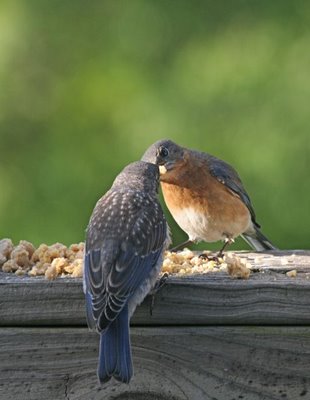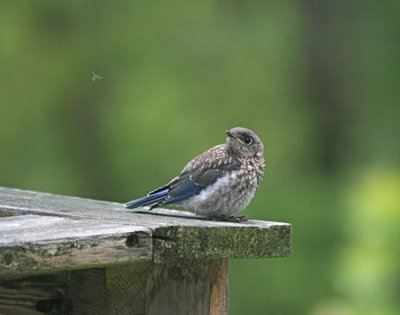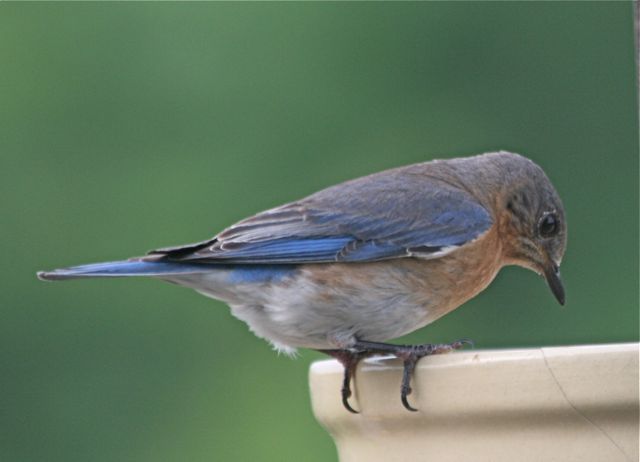
Upon viewing the bluebird foot photos, I put in a call to my favorite avian veterinarian: Robert Giddings, DVM, Diplomate, Association of Avian Veterinarians, of Kensington Bird and Animal Hospital in Kensington, Connecticut. Two decades ago, he was Charlie the macaw's veterinarian, he patched up my busted wild birds in return for help around the office, and I still turn to him with avian health questions.
Zick: "Hi, Bob. Can birds get gout?"
Bob: "Oh, yes. It's pretty common in caged birds. There was a pellet made by Pretty Bird that had too much protein and Vitamin D in it, that caused gout in quite a few cockatiels, but any diet that's too rich can cause it, just as it can in humans."
Zick: AH-HA!!!
I described the bluebird's feet to Bob--red, swollen, inflamed, and obviously causing the bird great pain. He agreed that articular gout was the most likely culprit. It's caused by a diet too high in protein (peanut butter?) and fat (lard-- You think?). Lots of purine in lard, it turns out. Gout is caused by an excess of uric acid in the body, which can be caused by increased intake of foods containing purines, which are metabolized to uric acid in the body. Over time, elevated levels of uric acid will lead to deposits of it in connective tissue around joints. Eventually, the uric acid may form crystals in the joints, leading to acute pain and inflammation.
In pet birds, gout is treated with alepurinol and colchicine, both antipurine medications, as well as pain medications. In wild birds, the only possible course would be to remove the offending food. I had already done that; had been cutting slowly back over the last three weeks. Now, I was putting out just enough "Zick dough" on occasional mornings to bring the birds in for a few minutes so I could photograph their poor little feet.
Bob: "Surely, these bluebirds are eating other things than this suet dough, right? A wild bird shouldn't overeat any one item when there are all kinds of natural foods out there."
Zick: "You'd have to know bluebirds. They are the ultimate addictive personalities. Offer them mealworms or suet dough, and they'll take the easy out every time, gorging on it to the exclusion of anything else."
Bob said that I should see a clearing of symptoms as time passed and the bluebirds resumed taking a natural diet. So for the past three weeks I have been photographing bluebird feet at every opportunity. It's become a little hobby. And I am delighted to say that the front yard male is standing strongly on both feet, showing just a little residual swelling in what we'd call his right "ankle"--the junction of his toes. And the backyard female now stands up tall on both feet, and the redness is gone, along with the worst of the swelling. She's not puffed up any more, and she's building a nest for her second clutch of eggs.
WHEWWW. I am so sorry, bluebirds. You deserve much better than to be fed mass quantities of a food that's flat-out bad for you. News flash: Mass quantities of mealworms are JUST AS BAD for bluebirds as is Zick dough. They're deficient in phosphorus, too high in protein and fat, and they mess the birds up. Don't feed mealworms in summer. Just stop it. They do not need your subsidy. I know, they'll tell you they're starving without you. Don't believe it.
I know there are many of you out there having tons o' fun feeding suet dough to birds this summer, watching them feed it to their babies. I've been doing that for years. I field calls all the time from people who have their birds addicted to mealworms, who suddenly panic when they go on summer vacation, and call me to ask what they should do about their bluebirds. Surely they'll starve without me!
What's wrong with this picture? It's the conceit that we are indispensible to wild birds; that our artificial foods (and yes, mealworms, fed to the exclusion of anything else, are an artificial food) are keeping them alive.
I have one plea. Stop NOW. Feed them in ice storms; when snow covers the ground; when they truly are having trouble finding food. Give it to them when it rains for a week in June and goes down to the 40's at night. But don't give it to them in the warmth of spring and summer when natural food is abundant, when the grasshoppers, crickets, spiders and caterpillars, bursting with nutrients and live enzymes and amino acids, are everywhere to be found. You wouldn't feed your kids candy for breakfast, lunch and dinner and expect them to thrive. Make no mistake: they'd be happy to have it, and they'd gobble it down and beg for more, but kids don't know what's bad for them. Neither, apparently, do wild birds. It's up to us to have the good judgement to do what's best for them.
 Bluebird fledgling, staring at a natural food item
Bluebird fledgling, staring at a natural food itemNever forget that we feed birds for our own pleasure and enjoyment, not because it's good for them. Feeding birds is a human conceit, and coming to the conclusion that they depend on us for their very survival is a scam that they encourage us to believe. Don't buy it. They're much, much better off without our food stamps. Mealworms or suet dough: if you're feeding your bluebirds every day, you're doing them no favors. You're compromising their health.

This photograph was taken June 12, 2008, of the same female bluebird who was suffering so in the photos taken May 28. Withholding the offending food has done wonders for her. See how the redness and swelling have subsided, and she's perching normally? Yaaaay!! She's having a little snack of mealworms here, in case you're wondering. And she'll have no subsidy for the rest of the month!






27 comments:
Gout... wow... whodathunkit. What about the commercial suet logs Julie? Same thing?
At one time in human history, gout was known as a rich man's (or person's) disease. Too much protein its usual cause.
Well, your most recent post underscores--gout is a rich bird's disease.
Most interesting.
You have made me feel better about not feeding my (oops--there I go) birds seeds in the summer.
We just keep disturbing natures balance even when we are trying to be good.
I can sympathize with the birds as I am plagued with kidney stones.
Both the stones and gout are caused by uric acid.
We put out small amounts of suet in the warmer weather to bring the red heads in. A bit of black oil sunflower for the nuthatches, jays, grosbeaks, woodpeckers and goldfinches. Nectar in the spring for hummingbirds and orioles, the Downey woodpeckers like nectar as well.
Niger for the ground feeders including raccoons, opossum, chipmunks and squirrels.
It's a big person who can admit a mistake, even when it hurts. Thanks for sharing, Julie. We know (and the bluebirds do, too) that no harm was intended. By this educational post, you have prevented all of us conceited bird feeders out there from doing the same thing.
I haven't fed my bluebirds since spring, and although I miss seeing their funny faces, I know they are better off without my "help."
Actually, I employ bluebirds and swallows to keep down the bug population around here, so by not feeding them, I am encouraging them to do their job!
For those of us who can't live without seeing our wild birds up close and personal, offering a fresh water source is a healthier (and cheaper) way of keeping them around.
Blue Skies to you and yours,
~Kathi
Gout: the Disease of King(lets).
Happy to hear it was a curable mistake. I thought there were actual missing digits in addition to swollen feet and couldn't see a good end.
I can either hold my hand over my eyes and drop the leftover Zick dough in the can or serve the rest in tiny portions. Sigh... We all know the birds don't need us as much as we need them :o) So I'll rely on some seeds and my pond to attract them. I'm not feeding them much now anyway.
I noticed that bluebirds have OCD when I served mealworms on campus. It didn't take long for them to realize I was the worm lady and actually stalked me. The Mockers do the same.
How about those commercial suet cakes? They don't gulp that suet down as quickly.
For you and the rest of us Zick Dough lovers, I'm sad. But we'll all be OK.
By the way, your photos are stunning, especially the one of the juvenile with its eye on a flying insect.
Thanks for the info, I usually just drop back to peanuts in the shell and fresh water in the several birdbaths around the yard. Peanuts in shell are popular with downy, hairy, blue jay, chickadee, nuthatch. They don't seem to mind the extra work, shells discourage the starlings and grackles from pigging out.
Agree with Katdoc on the fresh water, it gets pretty hot and dry in western South Dakota come July and August, I have many patrons of assorted bird baths.
Caroline in SD
Thank you for sharing your observations and research. I'm amazed. I had read somewhere about not feeding as much suet in the summer so I had finished up a batch I'd made and didn't intend to make more. My local birds love the suet dough but also keep eating the seeds I put out and come in waves so I know they are eating other foods as well. Still, no point in making it too easy for them -- nothing good comes from that.
Well done!
I have a bird feeder that sits empty almost all the time since our acreage is wild and loaded with natural food sources.
It means I may have to actually walk to find my bird photos,instead of sitting on the porch, but that doesn't seem like such a bad trade.
Great advice, Julie. The birds really do know how to find food when we're not around. It's probably best to encourage them to seek those natural sources. It keeps them safe from the backyard hawks who prowl the feeders looking for their easy meal too.
Thank you!
I had been feeling somewhat guilty for not getting around to making the Zick dough, which I had intended to do months ago. And with our extended cold spring and non-summer this year (It froze here two nights ago!), I felt that the birds needed a boost.
So now my habit of procrastination has turned out for the better. For once.
I have been throwing out a handful of assorted seed once a day, especially on really miserable days. Otherwise, clean water and lots of groundcover and shrubby bird hiding spaces is all I provide in warm weather. there are still a few sunflower seeds available in the chickadee feeder, but theyre not the addictive type, and come only for an occasional treat this time of year.
Oh, it's so good to see those little healthy birdy feets.
When my dear sweet cat, Butterball, was nearing the end earlier this year, he stopped eating. I was desperate and tried any cat food. He then started really chowing down on a certain cheaper cat food loaded with artificial colors and flavors. When I told my vet, he laughed and said at this stage it really didn't matter as long as he kept eating, and in the vet world they call that particular brand--kitty crack!
Purines...ooohh....yuck! Two bouts of graduate school stress for my husband has caused me to be acutely aware of gout.
What an interesting story arc. Thanks, Julie.
Thanks for the lesson; neat that you were able to make astute observations and quickly link them to diet (I sense a great article for BirdWatcher's Digest in the making here!! ;-)
I just can't get enough of your bird photos, Julie. Love these. Interestingly, I have blues post at my blog today as well. Annie
Hi,
I don't feed the Zick Dough recipe, but I started feeding a peanut butter/suet/cornmeal mix this past year. And yes, various species really LOVE it.
But then, this summer, the Blue Jays (along with the more appreciated red-bellied woodpeckers, other woodpeckers and some sparrows)found and equally loved it. Believing that jays would negatively influence the nesting success of other birds in our small woods (part of a fragmented woodland habitat), I, too, discontinued serving this delight.
I appreciate your sharing, Julie, of the negatives of addicting our wild birds to bird lovers' "candy". I only recently began feeding birds during the breeding season (we used to feed only during the colder months). I had hoped that birds understood their own nutritive needs, though I suspect that you have insight when you compare it to candy.
Helen Ostermiller
Medina County, OH
Hi,
I don't feed the Zick Dough recipe, but I started feeding a peanut butter/suet/cornmeal mix this past year. And yes, various species really LOVE it.
But then, this summer, the Blue Jays (along with the more appreciated red-bellied woodpeckers, other woodpeckers and some sparrows)found and equally loved it. Believing that jays would negatively influence the nesting success of other birds in our small woods (part of a fragmented woodland habitat), I, too, discontinued serving this delight.
I appreciate your sharing, Julie, of the negatives of addicting our wild birds to bird lovers' "candy". I only recently began feeding birds during the breeding season (we used to feed only during the colder months). I had hoped that birds understood their own nutritive needs, though I suspect that you have insight when you compare it to candy.
Helen Ostermiller
Medina County, OH
I was putting out a sprinkle of meal worms in three different feeders in the back yard once or twice a week. Until I noticed Mama Robin following me from dish to dish stuffing her mouth. She still hops and peeps at me whenever I go out back!
Dr. Zick, I presume? Your diligence in finding the cause/solution to the bluebird foot swelling is awe inspiring. And from it a timely and important post that all should read.
Before I got here on my regular round of reading -- I was actually informed of this post as a "must read" through the Oklahoma Bird list server earlier today. Another Okie had already passed through here and is spreading the word. The power of the blogosphere continues to amaze.
RE: Tim's comment, you are powerful. Wow, Dr. Zick.
Hmmm.
Such helpful info for us AND the birds. And, here I was feeling guilty for letting my feeders run dry until I get back on top of my crazy life!
When I learn things like this, I remind myself to "keep balance" in all things.
It seems the bad things happen when we swing too far either way, in this case, with diet.
Well, I can stop feeling guilty about the huge jar of prepared dough, in my fridge instead of out in the bird dish.
But seriously... I think that the success of the "Zick Dough" (even if it turned out to be aves heroin) is in part due to how much people think of you. This is NOT to make you feel bad, but instead I think it shows the passion we all have for birds and how we want the best for them, even if it turns out that it isn't.
It's not good for birds in large quantities. Or for Type A bluebirds. Now we know. And I hope you aren't losing sleep because of it.
Hi everyone. I'm writing from Hog Island. Today we go out on an all-day boat trip after puffins. I'm scrambling to clothe my kids, who are having the time of their lives.
Thanks for all the comments and support. I don't think commercial suet cakes have quite the fast-food allure that suet dough possesses. But a good rule might be to watch and see if any one bird or species of bird seems to be "hooked" on a food to the exclusion of anything else. As we now know, it happens! And they can wreck their health by indulging.
Summer feeding...maybe the coons that rip every feeder down each night are trying to tell us something?
My guys are getting a small scoop of mixed black oil and sunflower hearts, and a single peanut feeder with roasted cocktail peanuts. That's it.The bluebirds eat the sunflower hearts, even when there are crickets and caterpillars everywhere. Hmm.
Very interesting. For some strange reason my Blue Birds haven't got hooked on Zick dough. I think it's in part due to the fact that I feed it to the birds on a very infrequent basis.
I'll "moderate" for you and delete my comments. I'm sorry I ruffled your feathers.
Happy birding.
Nice pictures! I never heard of birds having gout. I don't use suet feeders but I have just started feeding our bluebirds mealworms twice a day.
It took them a few days to find the mealworms. I posted a couple pictures, check it out.
love your pictures!
Michael
Bluebirds Eating Live Mealworms
Post a Comment